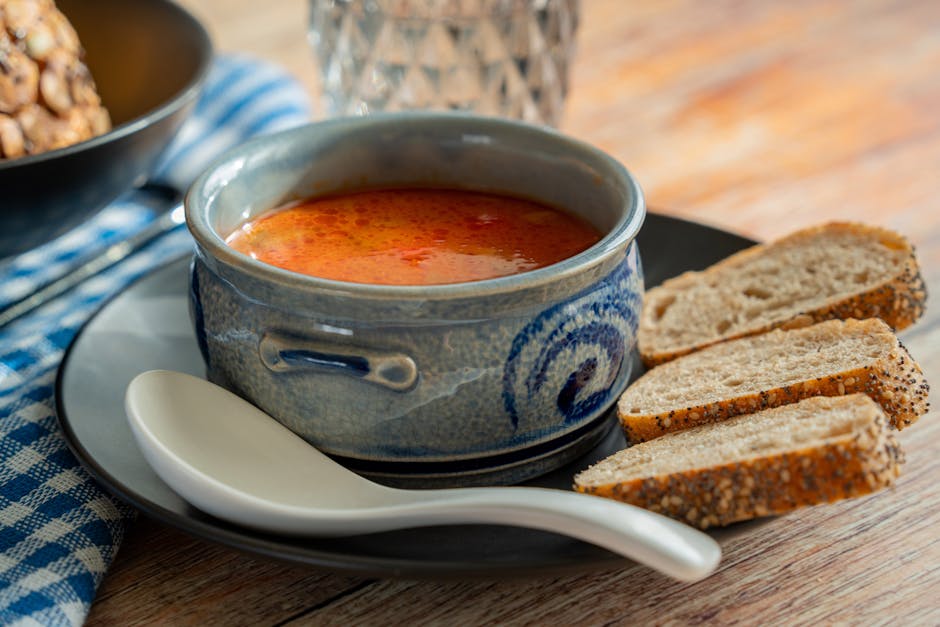Classic Chinese Hot and Sour Soup, a culinary cornerstone of Chinese cuisine, boasts a history as rich and complex as its flavor profile. While pinpointing its exact origin is difficult, its roots likely lie in the northern regions of China, possibly dating back centuries. The soup’s development was likely influenced by the readily available ingredients in these areas, such as tofu, mushrooms, and various vegetables, combined with the readily available vinegar and chili peppers that provide the characteristic hot and sour taste. Its evolution wasn’t a singular event but a gradual process of refinement across different regions and dynasties, with variations developing based on local preferences and available ingredients. The fundamental components, however, remained consistent: a harmonious balance of spicy heat, tangy sourness, and savory umami.
The soup’s popularity transcends geographical boundaries. It’s a staple in countless Chinese households, appearing regularly on family dinner tables and celebratory feasts. Beyond the home, it’s a ubiquitous dish in restaurants worldwide, a testament to its enduring appeal and adaptability. While precise statistics on global consumption are unavailable, the sheer number of recipes and variations found online and in cookbooks provides a clear indication of its immense popularity. Its adaptability is key; chefs worldwide have incorporated local ingredients and techniques, resulting in regional interpretations, from spicier Sichuan versions to milder Cantonese adaptations. This flexibility contributes to its international recognition.
Beyond its deliciousness, Hot and Sour Soup holds significant cultural weight. It’s often considered a restorative and comforting food, particularly during periods of illness or colder weather. The combination of warming spices and tangy vinegar is believed to stimulate the appetite and aid digestion, making it a popular remedy for those feeling under the weather. Furthermore, the soup’s presence at family gatherings and celebratory meals underscores its social significance. It’s more than just a dish; it’s a symbol of togetherness, comfort, and shared culinary heritage. The act of sharing this soup often transcends mere sustenance, becoming a powerful representation of family bonds and cultural identity. Its enduring presence on menus and in homes across the globe stands as a testament to its culinary significance and lasting appeal.
Ingredients and Measurements
Crafting a truly authentic and delicious Classic Chinese Hot and Sour Soup hinges on the precise measurement and quality of your ingredients. Don’t be tempted to substitute liberally; each element plays a crucial role in achieving the desired balance of flavors and textures.
Broth: The foundation of this soup is a flavorful broth. We recommend using 6 cups (1.4 liters) of chicken broth for a richer taste, but you can substitute with vegetable broth for a vegetarian version. Ensure your broth is well-seasoned; a subtly salty and savory base is key. Avoid using overly salty broth, as you’ll be adding other seasonings later. Homemade broth, if possible, will elevate the overall taste significantly.
Protein: Traditionally, pork is used, but you can easily adapt this recipe. We recommend 6 ounces (170 grams) of pork loin, thinly sliced. If using pork, ensure it’s lean to avoid an overly greasy soup. You can substitute with 6 ounces (170 grams) of firm tofu, cubed, for a vegetarian option, or 6 ounces (170 grams) of cooked chicken, shredded. The protein should be added towards the end of the cooking process to prevent it from becoming tough.
Mushrooms: The earthy flavor of mushrooms adds depth. Use 4 ounces (115 grams) of dried wood ear mushrooms, rehydrated according to package instructions. Alternatively, you can use 6 ounces (170 grams) of fresh shiitake mushrooms, sliced thinly. Wood ear mushrooms are traditional, but shiitake mushrooms provide a good substitute if unavailable. Remember to remove the tough stems from the shiitake mushrooms before slicing.
Vegetables: The vegetables contribute both flavor and texture. We’ll use 1/2 cup (75 grams) of shredded Napa cabbage, providing a delicate sweetness. Add 1/4 cup (30 grams) of thinly sliced green onions (both white and green parts) for a fresh, pungent element. Ensure your vegetables are finely chopped or sliced for even cooking. A combination of finely chopped carrots and celery can also be added for extra flavor and nutrition, approximately 1/4 cup (30 grams) each.
Starch: Cornstarch is used as a thickening agent. Mix 1 tablespoon of cornstarch with 2 tablespoons of cold water to create a slurry. This slurry should be added slowly at the end of cooking to prevent clumping. This will give the soup the desired consistency.
Seasoning: The magic of this soup lies in its balance of hot and sour flavors. Use 2 tablespoons of rice vinegar for the sourness, and adjust to taste. Add 1-2 teaspoons of black vinegar for added complexity and depth. For the heat, use 1-2 teaspoons of chili garlic sauce, or to your preference. Start with less chili garlic sauce and add more gradually to control the spiciness. Season with 1 teaspoon of salt and 1/2 teaspoon of white pepper. Finally, add a dash of sesame oil (about 1/2 teaspoon) for aroma.
Egg: A beaten egg is added at the very end, creating delicate ribbons in the soup. Use 1 large egg, lightly beaten. Drizzle the egg slowly into the simmering soup for optimal effect, creating thin strands rather than large clumps.
Garnish (Optional): Garnish with extra green onions, a sprinkle of sesame seeds, and a drizzle of chili oil for an extra layer of flavor and visual appeal.
Mise en Place (Preparation of Ingredients)
The success of a Classic Chinese Hot and Sour Soup hinges significantly on meticulous preparation of ingredients. This mise en place ensures efficiency and consistency in flavor. We’ll be making a soup for 4-6 servings.
Protein: Begin by preparing your protein. For this recipe, we’ll use 6 ounces of pork loin. Cut the pork into thin, 1/8-inch slices. This ensures even cooking and prevents toughness. Thicker slices will result in chewy pork. You can substitute with chicken breast, tofu, or shrimp, adjusting the quantity accordingly. If using tofu, press it firmly to remove excess water before cutting into cubes.
Vegetables: The vibrant flavors of this soup come from a variety of carefully prepared vegetables. We’ll need 1 cup of wood ear mushrooms (cloud ear mushrooms), 1/2 cup of black fungus mushrooms (easily found in Asian grocery stores), and 1/2 cup of shredded carrots. Soak the wood ear and black fungus mushrooms in warm water for at least 30 minutes, or until softened. This rehydrates them, making them tender and flavorful. Once softened, rinse them thoroughly under cold water, squeezing out excess moisture. Then, roughly chop the wood ear mushrooms and slice the black fungus mushrooms thinly. Shred the carrots using a grater or mandoline for even cooking.
Aromatics and Spices: The aromatic base is crucial. Finely mince 2 cloves of garlic and 1 inch of ginger. Using a microplane or fine grater will yield the best results, ensuring even distribution of flavor throughout the soup. Prepare 2-3 dried red chilies, breaking them into smaller pieces for a more controlled level of spiciness. Adjust the quantity to your preference. For a milder soup, remove the seeds from the chilies before using them.
Broth and Seasoning: Prepare 6 cups of chicken or vegetable broth. You can use store-bought broth or make your own for a deeper flavor. Have 2 tablespoons of rice vinegar, 1 tablespoon of soy sauce (light or dark, to your preference), 1 tablespoon of cornstarch, and 1 teaspoon of sesame oil ready. Dissolve the cornstarch in 2 tablespoons of cold water to create a slurry. This prevents clumping when added to the boiling soup, ensuring a smooth, thickened consistency. Measure out your seasonings accurately for balanced flavor.
Garnish: Finally, prepare your garnishes. Finely chop 2 scallions (both white and green parts) and set aside. Consider adding a squeeze of fresh lime juice before serving for extra brightness. A sprinkle of toasted sesame seeds adds a pleasant nutty aroma and texture. Having these ready will allow you to quickly finish and serve your soup once it’s cooked.
Important Note: Having all your ingredients prepped and measured before you begin cooking will streamline the process and allow you to focus on the cooking technique. This will result in a more flavorful and perfectly cooked hot and sour soup.
Broth Preparation
The foundation of a truly exceptional Classic Chinese Hot and Sour Soup lies in its broth. A well-made broth provides the depth of flavor that elevates this dish from good to unforgettable. This section details the process of crafting a flavorful and balanced broth, crucial for achieving the signature taste.
We’ll begin with a simple yet effective method that utilizes readily available ingredients. Start with 8 cups (approximately 1.9 liters) of chicken broth. You can use store-bought low-sodium broth for convenience, or, for a richer flavor, prepare your own by simmering chicken bones and aromatics (like ginger and scallions) for at least 2 hours. If using homemade broth, strain it thoroughly before proceeding to ensure a clear base.
The next crucial step involves building layers of flavor. To the chicken broth, add 1/4 cup (60ml) of rice vinegar. This provides the essential sour element. Do not use white vinegar, as it will lack the nuanced flavor of rice vinegar. Next, incorporate 2 tablespoons of soy sauce for saltiness and umami. Adjust to your taste preference, but start with this amount to ensure a balanced flavor profile. For a touch of sweetness that counteracts the sourness, add 1 tablespoon of Shaoxing rice wine. If you don’t have Shaoxing rice wine, dry sherry can be used as a substitute, though the flavor will differ slightly.
Careful attention to aromatics is key to a complex broth. Finely mince 2 cloves of garlic and 1 inch piece of ginger. Add these to the broth along with 2 dried red chilies, broken into pieces (adjust the quantity according to your spice preference). For a more pronounced chili flavor, you can add a pinch of chili flakes. These aromatics infuse the broth with warmth and depth of flavor. Bring the mixture to a gentle simmer over medium heat, ensuring it doesn’t boil vigorously. Simmering for 15-20 minutes allows the flavors to meld and deepen.
Proper seasoning is vital. Taste the broth carefully after simmering and adjust the seasoning as needed. You might want to add a touch more rice vinegar for extra sourness, soy sauce for saltiness, or a pinch of sugar to balance the flavors further. Remember to taste frequently and adjust accordingly. The goal is a harmonious balance of sour, salty, and sweet, with a subtle background heat from the chilies.
Once the broth is perfectly seasoned, strain it again through a fine-mesh sieve or cheesecloth to remove any solids, ensuring a beautifully clear and flavorful base for your hot and sour soup. Discarding the solids after straining is important for maintaining the broth’s clarity and preventing any lingering bitterness from the chilies or ginger. Your superbly crafted broth is now ready to be combined with the other ingredients to complete your Classic Chinese Hot and Sour Soup.
Cooking the Vegetables and Tofu
This section details the preparation and cooking of the vegetables and tofu for your Classic Chinese Hot and Sour Soup. Properly cooking these ingredients is key to achieving the perfect balance of textures and flavors in the final dish. We’ll be focusing on maintaining the vegetables’ crispness while ensuring the tofu is cooked through but not mushy.
Begin by preparing your vegetables. We’ll be using approximately 1 cup of mixed vegetables, including 1/2 cup of sliced wood ear mushrooms (pre-soaked and drained), 1/4 cup of thinly sliced scallions (white and light green parts only, reserving the dark green parts for garnish), and 1/4 cup of shredded carrots. The wood ear mushrooms add a wonderful earthy texture, while the scallions and carrots provide a vibrant color and subtle sweetness. Feel free to adjust the vegetable selection to your preference; bok choy, spinach, and bamboo shoots are all excellent additions.
Next, prepare your tofu. We recommend using 1 block (approximately 14 ounces) of firm or extra-firm tofu. Drain the tofu well and then press it to remove excess water. This step is crucial; excess water will dilute the soup and prevent the tofu from absorbing the flavorful broth. You can achieve this by wrapping the tofu in several layers of paper towels and placing a heavy object on top for at least 15 minutes. Alternatively, you can use a tofu press for faster and more efficient water removal. Once pressed, cut the tofu into 1/2-inch cubes. This ensures even cooking and a pleasant mouthfeel.
Heat 2 tablespoons of vegetable oil in a wok or large skillet over medium-high heat. Once the oil is shimmering, add the carrots and wood ear mushrooms. Stir-fry for approximately 2-3 minutes, until the carrots begin to soften slightly but still retain their crispness. Avoid overcrowding the pan; work in batches if necessary to ensure even cooking.
Add the tofu cubes to the wok and gently stir-fry for another 2-3 minutes, until lightly browned on the edges. Do not overcook the tofu; it should remain firm and not break apart. Be careful not to break the tofu cubes while stirring. The goal is to gently sear the tofu for a slightly crispy exterior while maintaining a soft interior.
Finally, add the sliced scallions (white and light green parts) to the wok and stir-fry for another minute, just until fragrant. Remove the cooked vegetables and tofu from the wok and set aside. Keep the cooked vegetables and tofu warm while you prepare the rest of the soup. This ensures that everything is ready to combine at the end, creating a delicious and perfectly balanced hot and sour soup.
Remember to taste and adjust seasoning as needed throughout the process. The final result should be a vibrant and flavorful soup with a delightful combination of textures and temperatures.
Adding the Protein (if using)
While classic Chinese Hot and Sour Soup is delicious on its own, adding protein elevates it to a heartier and more satisfying meal. The type of protein you choose will significantly impact both the flavor and texture of the final soup. Popular choices include pork, chicken, shrimp, and tofu. This section will guide you through the process of adding protein, regardless of your selection.
Choosing Your Protein: The cooking time for each protein varies drastically. Pre-cooking your protein is strongly recommended to ensure it’s fully cooked and doesn’t overcook in the soup. This prevents tough, rubbery meat and ensures even heating. For example, thinly sliced pork belly or tenderloin benefit from a quick stir-fry before adding to the soup. Chicken breast, cut into bite-sized pieces, should be poached or lightly stir-fried until cooked through. Shrimp should be peeled and deveined, then quickly sautéed or blanched. Firm tofu, cubed, requires a simple pan-fry to add a slightly crispy exterior. Avoid adding raw protein directly to the boiling soup, as this can lead to uneven cooking and affect the overall texture and taste.
Quantities: The amount of protein you add depends on the number of servings and personal preference. A good guideline is approximately 6-8 ounces of protein for 4-6 servings of soup. This translates to roughly 150-200 grams. Adjust this according to your needs. For example, if you are using a combination of proteins, such as both shrimp and pork, you might use 4 ounces of each.
Preparation and Timing: Once your protein is pre-cooked, set it aside. Proceed with making the soup base according to your recipe instructions. Just before adding the cornstarch slurry (which thickens the soup), gently incorporate your pre-cooked protein into the simmering soup. Adding the protein at this stage is crucial because it allows it to heat through thoroughly without overcooking. Do not boil vigorously after adding the protein; simply maintain a gentle simmer for a minute or two to ensure everything is heated evenly and the flavors meld.
Specific Protein Recommendations:
- Pork: 6-8 ounces thinly sliced pork belly or tenderloin, stir-fried until lightly browned before adding to the soup.
- Chicken: 6-8 ounces boneless, skinless chicken breast, cut into bite-sized pieces, poached or lightly stir-fried until cooked through.
- Shrimp: 6-8 ounces peeled and deveined shrimp, sautéed or blanched until pink and opaque.
- Tofu: 6-8 ounces firm or extra-firm tofu, cubed and pan-fried until lightly golden brown.
Important Note: If you are using a delicate protein like shrimp, add it during the last minute of cooking to prevent it from becoming rubbery. Always ensure your protein is thoroughly cooked before serving to avoid foodborne illnesses. Remember to adjust seasoning after adding the protein, as it might slightly alter the overall flavor profile.
Seasoning and Flavor Balancing: The Heart of Hot and Sour Soup
Seasoning is paramount in achieving the authentic, complex flavor profile of Classic Chinese Hot and Sour Soup. It’s a delicate dance between sour, spicy, salty, and umami, with a hint of sweetness to balance it all. Getting this right elevates a good soup to a truly exceptional one. This section details the crucial steps involved.
The foundation of your seasoning starts with the broth. A flavorful broth is essential. While you can use store-bought chicken or vegetable broth, homemade broth offers superior depth. If using store-bought, choose a low-sodium option to control the salt level. Aim for about 6 cups of broth for a standard recipe.
Acidity is key to the sour in hot and sour soup. Traditionally, this is achieved using rice vinegar (about 2 tablespoons), which offers a bright, clean acidity. Black vinegar can also be used for a deeper, more complex sourness (use approximately 1-1.5 tablespoons), but be mindful of its stronger flavor. Experiment to find your preferred balance. Start with less and add more gradually. The acidity should be noticeable but not overpowering.
Spice is essential for the hot . Freshly ground Sichuan peppercorns are highly recommended for their unique numbing sensation (about 1 teaspoon). Dried chili flakes or a small amount of chili oil (1/2 – 1 teaspoon) contribute heat. Adjust the amount of chili according to your spice preference. Start with a smaller quantity and add more cautiously. Remember that the heat will intensify as the soup simmers.
Salt plays a crucial role in flavor balance. Add salt gradually (start with 1 teaspoon) throughout the cooking process, tasting frequently. Never add all the salt at once. The saltiness should complement the other flavors, not dominate them. Remember that other ingredients like soy sauce and fermented black beans also contribute saltiness.
Umami adds depth and richness. Soy sauce (1-2 tablespoons) provides a savory umami boost. Consider adding a teaspoon of MSG (monosodium glutamate) for a more pronounced umami flavor. Many find that MSG enhances the overall taste without being detectable. However, it is optional and can be omitted if preferred.
A touch of sweetness balances the other flavors. A small amount of sugar (1/2 teaspoon) can subtly enhance the overall taste. It helps to round out the sharp notes of the vinegar and chili. This is often overlooked, but it’s a crucial step in achieving a harmonious flavor profile. Don’t overdo it; a little sweetness goes a long way.
Finally, taste and adjust. The most crucial step is tasting your soup throughout the cooking process. Adjust the seasoning according to your preference. There is no single correct way to season hot and sour soup. The beauty lies in finding the balance that best suits your palate. Take your time, experiment, and enjoy the journey of creating your perfect bowl of hot and sour soup.
Recommendations for Classic Chinese Hot and Sour Soup
Our Classic Chinese Hot and Sour Soup is a delightful balance of spicy, sour, and savory flavors. To enhance your dining experience, we offer the following recommendations:
Serving Suggestions: For the best enjoyment, serve the soup hot, ideally straight from the stovetop or after a brief warm-up in the microwave. The ideal serving temperature allows the complex flavors to fully bloom and the ingredients to maintain their optimal texture. We recommend ladling the soup into individual bowls, allowing the vibrant colors and aromatic steam to entice the appetite. Garnish each bowl with a sprinkle of freshly chopped scallions for an added touch of freshness and visual appeal. A small drizzle of chili oil can add an extra kick for those who prefer a spicier soup. Consider serving it as a starter before a larger meal, or as a light and satisfying lunch on its own.
Storage Conditions: For optimal freshness, store leftover soup in an airtight container in the refrigerator. The soup should be consumed within 3-4 days of preparation. Avoid storing the soup for extended periods as the flavors and textures may degrade over time. When reheating, ensure the soup is heated thoroughly to a steaming temperature to eliminate any potential bacteria. For best results, reheat gently on the stovetop, avoiding a rapid boil which can cause the soup to become watery.
Complementary Dishes: The versatility of our Hot and Sour Soup makes it an excellent pairing with a wide range of dishes. It complements lighter fare such as steamed dumplings (jiaozi) or spring rolls beautifully. For a more substantial meal, consider pairing it with stir-fried dishes featuring chicken, pork, or tofu. The slightly tangy and spicy nature of the soup cuts through the richness of many meats and vegetables. Dishes with a neutral or slightly sweet flavor profile are particularly well-suited, preventing a clash of tastes. Consider serving it alongside a simple side of plain rice to absorb the flavorful broth.
Nutritional Information (per serving, approximate): Calories: 150-200 (depending on ingredients and serving size). Protein: 8-12g (primarily from tofu and/or meat). Fat: 5-8g (depending on the amount of oil used). Carbohydrates: 15-20g (primarily from noodles and vegetables). Fiber: 3-5g (from vegetables). Sodium: Variable – depends on the amount of soy sauce and other seasonings used. Please note that these are estimates and may vary depending on specific recipe variations and ingredients used.
Important Note: While generally safe for most individuals, those with specific dietary restrictions or allergies should carefully review the ingredients list to ensure that the soup aligns with their needs. Adjust the spice level according to your preference by modifying the amount of chili garlic sauce or chili oil.





